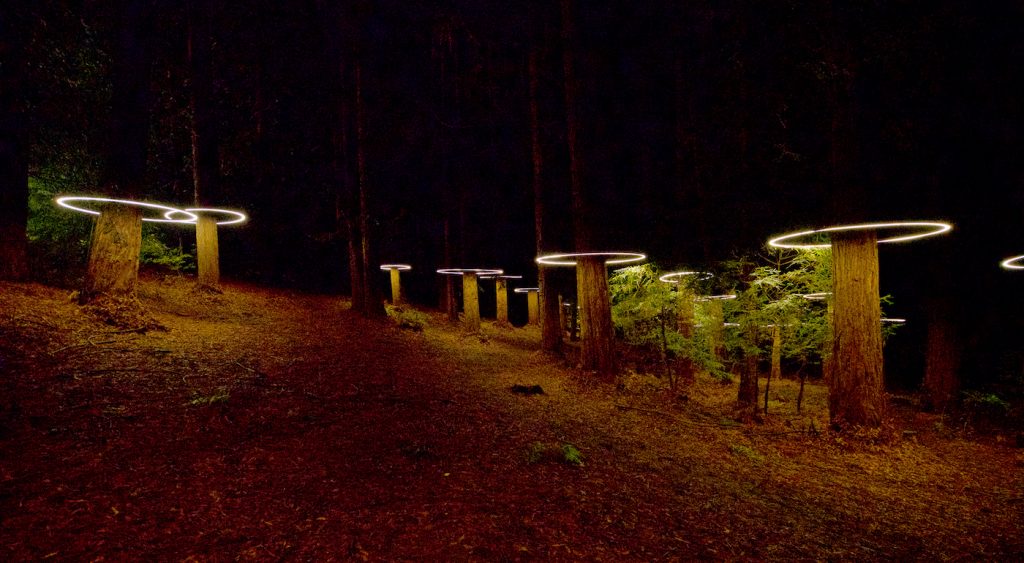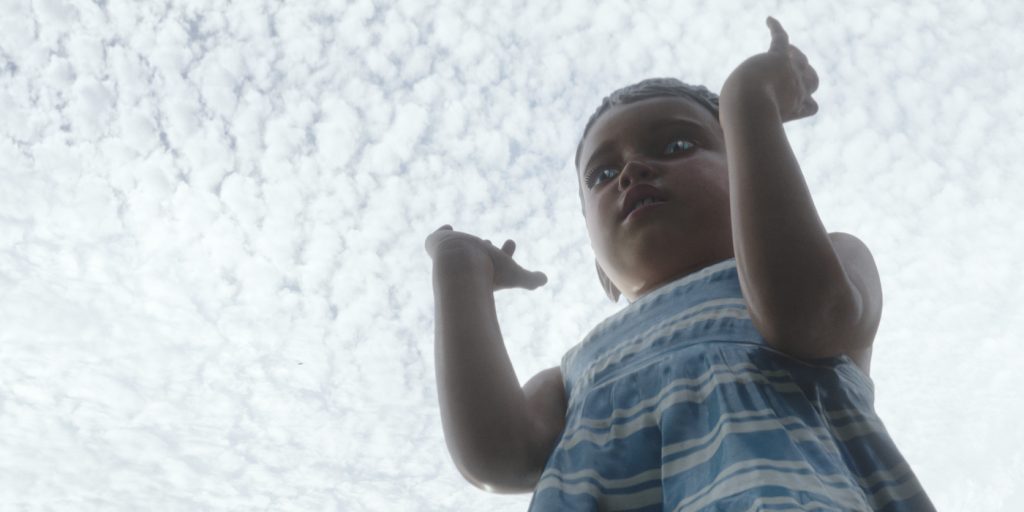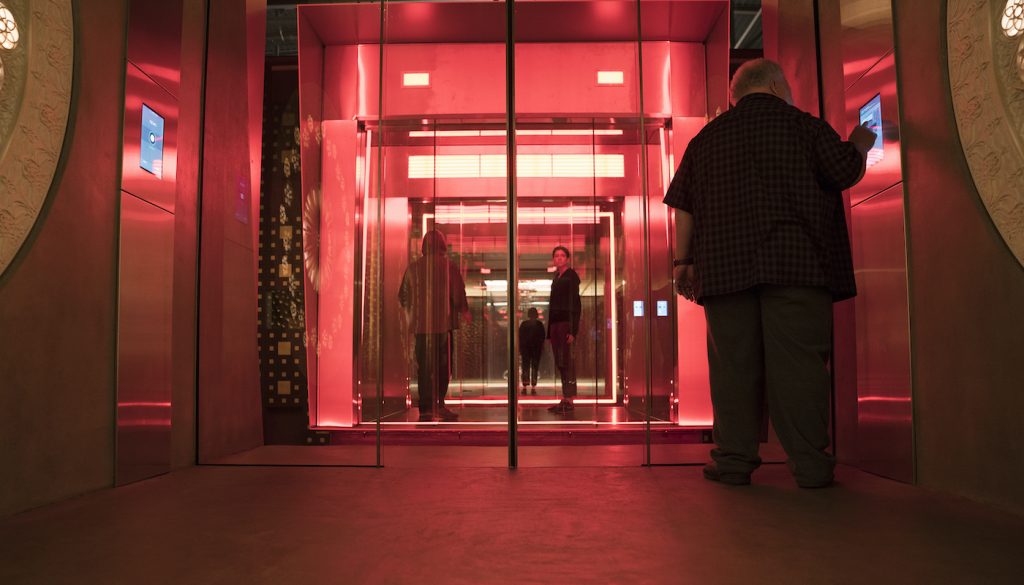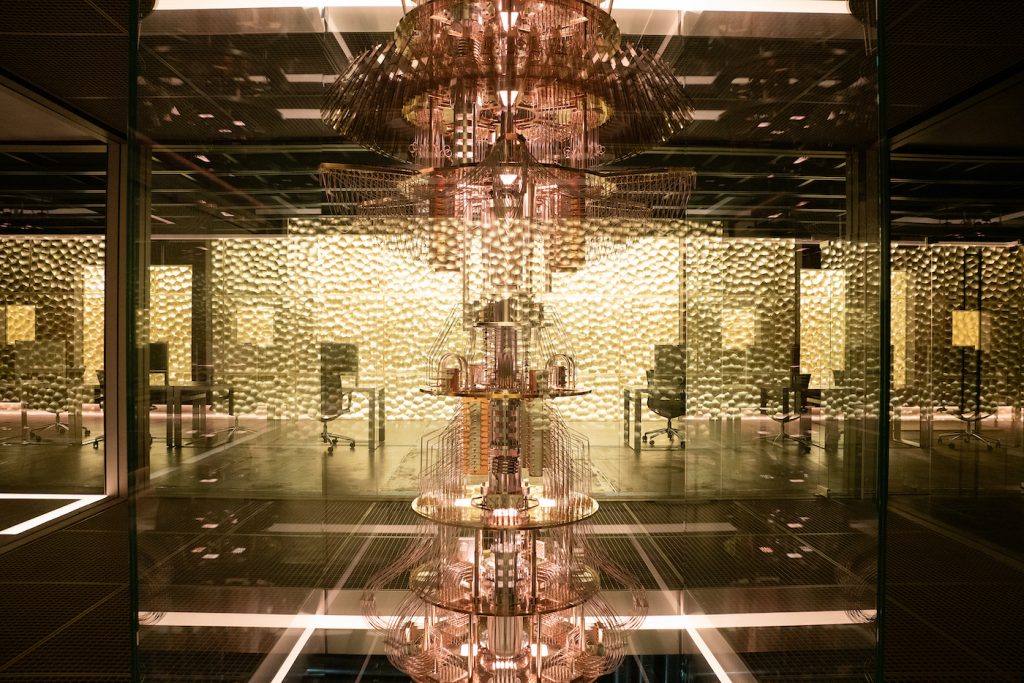Devs Production Designer Embellishes Big Tech Aesthetic in Alex Garland’s Gorgeous, Beguiling Series
What if a Silicon Valley behemoth ran a top-secret project that threatened the well-being of unwitting civilians? That’s the not entirely outlandish premise underlying Devs, now streaming on FX on Hulu. Created by Ex Machina and Annihilation director Alex Garland, the sci-fi limited series largely takes place at a sleek big tech “campus” surrounded by woods.

The exteriors evoke Google, Apple, and Facebook headquarters, but the fictional “Amaya Corporation” also incorporates weird twists to reflecting the obsessions of its revered founder Forest (Nick Offerman). Trees are encircled by halo-like rings of light while a floating “Cube” provides workspace to researchers attempting to master time and space; The entire enterprise is dominated by a giant sculpture of a six-year-old girl that looms over the campus like a saucer-eyed Statue of Liberty.

Filmmakers staged interiors in Manchester, England, and shot exteriors in the Palo Alto area. To burnish the bucolic northern California locations with surreal touches, Garland turned to production designer Mark Digby. BAFTA-nominated for his contributions to Slumdog Millionaire, Digby, who previously teamed with Garland on Ex Machina and Annihilation, talks about how he and his collaborators nudged big tech architectural aesthetics to the next level.
What was your creative brief for the look and feel of Amaya, the tech company at the heart of the series?
We wanted the architecture and the setting to reflect current Silicon Valley tech companies. We also talked about Amaya Campus being the next incarnation of those companies with interior playgrounds and exotic meeting spaces. We found this powerful modernist science-based concrete geometric campus that was, importantly, set in a Californian Redwood forest. That setting allowed us to impose strong visuals of the natural redwood trees with the man-made elements.
Like Apple headquarters, Amaya is super-sleek and surrounded by greenery. Did you visit Apple in Cupertino?
Yes. We looked at all the leading players in Silicon Valley. “Integrity research” is an important element of our design approach.
Adding mystery to the Amaya campus is the giant sculpture of the little girl that looms over the campus. How did you develop that sculpture?
Amaya was fully created through computer modeling and visual effects. A child actress was scanned and photographed in a few poses We then chose the pose, the size, and the photo-realistic look with our visual effects team led by Andrew Whitehurst. It was a big technical challenge because a structure of that size has all kinds of shadow and lighting implications during shooting, and the tone of its texture is very important.
The trees at Amaya seem to be encircled by rings of light. Were those lights added digitally or built practically?
The lights around the trees were practical. Alex, [set director] Michelle Day and I had initially gone down the route of doing Christmas tree fairy lights or carnival lighting threads, but then we decided to do something more visually and dramatically interesting. Achieving the rings practically was wildly challenging because it required a big electrical build by the practical lighting team led by Kevin Fitzpatrick and the on-set lighting team led by Lee Walters.
The floating “Cube” building connects to a corridor leading to the outside world via this glass elevator evidently supported by an invisible force field. It’s all very elegant to look at but must have been complicated to create.
The lift needed to move as if floating across the void with a dock on either side. It had to have working practical doors, and it needed to have enough structural integrity to safely carry actors and crew 20 feet above the studio floor. The Devs floating building that the lift docks onto has a specific geometry known as Menger Sponge.
Since the lift stood between the floating cube and the entrance corridor, we reduced any lines, joins, or pillars that might obscure or distract the visual throughline looking from the corridor through to the floating cube. All the framework around the door and door mechanics were made as slim or invisible as possible. It was also important to film simple traveling and action/drama scenes in what could have otherwise been a claustrophobic environment if the walls had been made of non-see-thru material. A glass-walled cube was our solution. There’s nowhere to hide people or equipment in a 360-degree room, but creatively we’ve always embraced the visual opportunities that come from transparent and reflective surfaces, so we felt well equipped to deal with that.

How did you get the lift to look like it was floating?
We placed the 12-foot cubed glass and metal structure on a giant trolley, which was later removed with CGI in post. It sits 15 feet off the ground and rolls when pushed manually, across the void before docking perfectly on either side. This required highly precise construction of the lift and its rolling mechanism as well as the docking points on the main sets of the corridor and floating cube. Anything less than perfect would show as a shudder and undermine the quality of the Devs building that we, as the audience, are buying into.
The glittering quantum computer at the heart of the mission possesses an almost mystical grandeur, in keeping with the CEO’s ambitious quest. What went into the design of this showpiece computer?
The starting point is the quantum computer technology that actually exists, so we went to see the real machines. They were far larger and more visually stimulating than we expected, with very fine circuitry, cooling tubes, wires, and highly finished materials including gold, aluminum, glass, and copper. It looked like a fine chandelier in shape and composition. We then took all of that even further to multiply the scale and magical beauty. Our final piece was more than 12 feet high and five feet in diameter, heavy but also very delicate. Its fabrication required craftsmen, 3D printing, laser cutting, fine lathe and metalwork, mirror quality metal surface polishing, complex electronic circuitry, delicate ally pipes with replicated bends, and intricate steel wirework. We transported the piece from our workshop in London to a studio in Manchester and from there, installed it at the Devs studio set 20 feet in the air, which was challenging.

Additional to real-life quantum computers, what did you draw on for visual inspiration while designing the Devs machine?
We looked at historical and modern architecture, cathedrals, mosques, temples, grand lighting, and chandelier designs. We studied fine art structures and sculptures, fluid motion, motion photography, jewelry, microscopic organisms, interstellar photography, fine electronics and so much more. Our computer needed to be elegant and finely crafted, like a giant piece of practical electronic jewelry.
Featured image: DEVS “Episode 8” (Airs Thursday, April 16) — Pictured: (left) Sonoya Mizuno as Lily. CR: Miya Mizuno/FX



